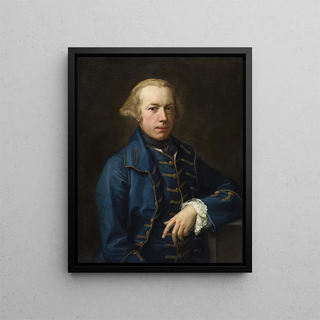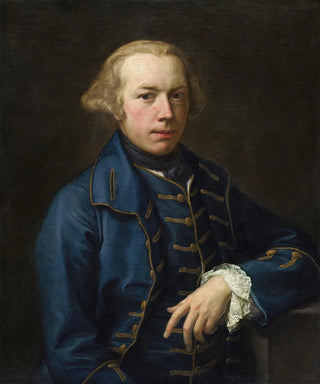Art print | Portrait of a gentleman - Pompeo Batoni


View from behind

Frame (optional)
In the fascinating world of 18th-century painting, the "Portrait of a Gentleman" by Pompeo Batoni stands out as an iconic work, showcasing the elegance and refinement of its era. This painting, which embodies both technical virtuosity and psychological depth, invites viewers to immerse themselves in a world where social status and aesthetics meet in rare harmony. Contemplating this piece transports one to Baroque Italy, a moment when art and culture intertwined to create timeless images.
Style and uniqueness of the work
The "Portrait of a Gentleman" is distinguished by its characteristic style, blending meticulous realism with a carefully orchestrated composition. Batoni, master of the portrait, captures not only the physical features of his subject but also their essence and character. The soft light caressing the gentleman's face, the sumptuous drapery of his clothing, and the delicately chosen background all contribute to creating an atmosphere of dignity and serenity. Every detail, from the penetrating gaze to the textures of the fabrics, reflects a refined aesthetic pursuit, revealing the artist's skill in playing with shadows and light. This portrait, far from being a simple representation, becomes a window into the soul of the subject, an invitation to explore the nuances of their existence.
The artist and his influence
Pompeo Batoni, born in Lucca in 1708, is recognized as one of the most prominent portraitists of his time. His style, which combines classical and baroque influences, marked a generation of artists and helped redefine the portrait as a genre. Batoni established himself in Rome, attracting a prestigious clientele, from aristocrats to foreign dignitaries, all eager to be featured in his compositions. His innovative approach, which combines drawing precision with a subtle palette, inspired many artists, particularly within the Italian school. By admiring the "Portrait of a Gentleman," one perceives not only Batoni's technical mastery but also his fundamental role in the evolution of portraiture in the 18th century.

Matte finish

View from behind

Frame (optional)
In the fascinating world of 18th-century painting, the "Portrait of a Gentleman" by Pompeo Batoni stands out as an iconic work, showcasing the elegance and refinement of its era. This painting, which embodies both technical virtuosity and psychological depth, invites viewers to immerse themselves in a world where social status and aesthetics meet in rare harmony. Contemplating this piece transports one to Baroque Italy, a moment when art and culture intertwined to create timeless images.
Style and uniqueness of the work
The "Portrait of a Gentleman" is distinguished by its characteristic style, blending meticulous realism with a carefully orchestrated composition. Batoni, master of the portrait, captures not only the physical features of his subject but also their essence and character. The soft light caressing the gentleman's face, the sumptuous drapery of his clothing, and the delicately chosen background all contribute to creating an atmosphere of dignity and serenity. Every detail, from the penetrating gaze to the textures of the fabrics, reflects a refined aesthetic pursuit, revealing the artist's skill in playing with shadows and light. This portrait, far from being a simple representation, becomes a window into the soul of the subject, an invitation to explore the nuances of their existence.
The artist and his influence
Pompeo Batoni, born in Lucca in 1708, is recognized as one of the most prominent portraitists of his time. His style, which combines classical and baroque influences, marked a generation of artists and helped redefine the portrait as a genre. Batoni established himself in Rome, attracting a prestigious clientele, from aristocrats to foreign dignitaries, all eager to be featured in his compositions. His innovative approach, which combines drawing precision with a subtle palette, inspired many artists, particularly within the Italian school. By admiring the "Portrait of a Gentleman," one perceives not only Batoni's technical mastery but also his fundamental role in the evolution of portraiture in the 18th century.






